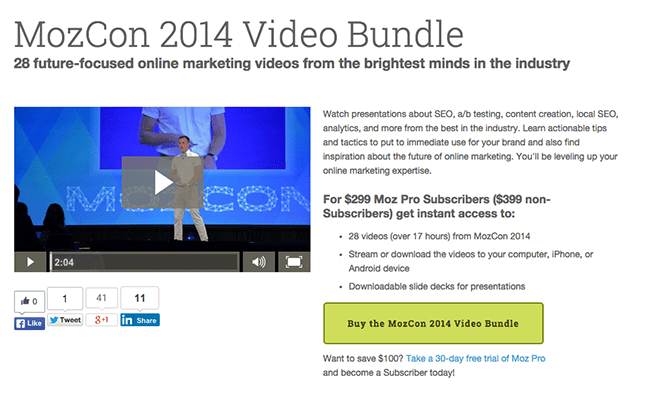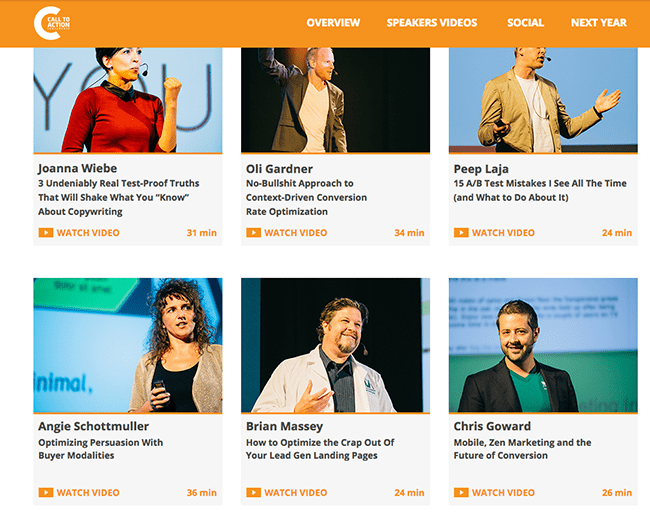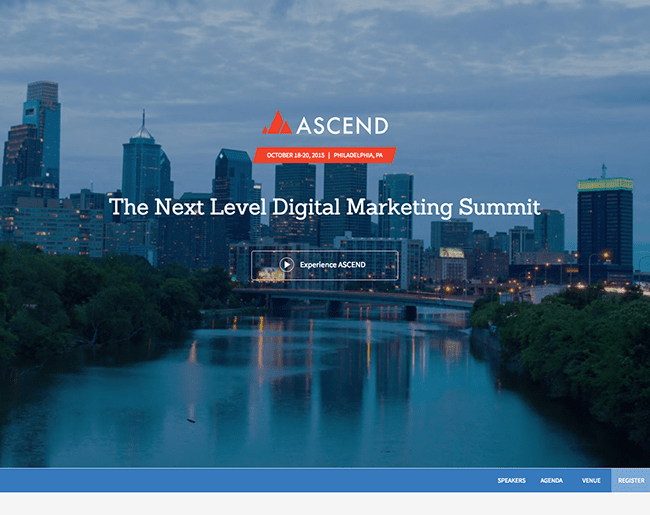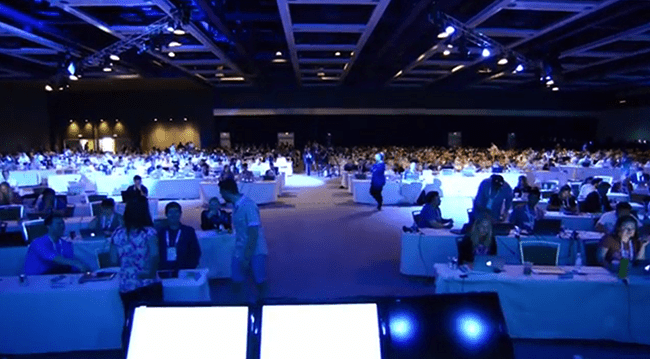Anyone who’s attended a lot of conferences knows that energy drives success in the event world. A feeling of excitement and inspiration prompts people to attend in the first place and then come back each year. It’s also the reason people share their experiences afterwards.
A great way to foster this energy amongst conference-goers (and potential conference-goers) is to incorporate video into your conference promotion strategy. Just check out this video from the Email Design Conference — everything from its pace to its music conveys energy and excitement:
Equally important is a feeling of intimacy.
Regardless of whether you have 10 people or 10,000 people attending your conference, every attendee should feel connected with each other, with your brand and with speakers on a more personal level.
Ready to create more feelings of intimacy, energy and enthusiasm among your attendees and get people coming back for more year after year? Let’s look at ways you can successfully use video to promote your conferences – before, during and after the event.
Before the event
Using video before your event is all about generating enthusiasm for people who have already purchased tickets as well as persuading those who are on the fence about attending.
By offering a conference sneak peak, you give people a feel for what their experience will be like.
Take a minute to watch this video produced by Moz for last week’s MozCon. Not only will you get goosebumps from watching the video, but you’ll probably also feel a bit of regret if you missed out on it:
Keep these best practices in mind when using video before your event kicks off:
- Include plenty of B-roll footage. B-roll refers to footage that’s distinct from the primary content of the conference. It’s the footage of people chatting, sharing a beer, having lunch. It might be paired with a voiceover about how the event brings people together for learning, as well as fun. It’s the B-roll that really gives people a feel for the tone of the event.
- Include testimonials from many different voices and personas. You want your potential attendees to be able to imagine themselves participating.
- Don’t try to do too much with a single video. If you’re trying to generate enthusiasm, keep the video short and sweet and focused on that single goal.
What should that single goal be? Here are some examples of how video can play a role before your event begins.
Save the date
Create a fun and compelling video to remind people to save the date for your upcoming event. More compelling than just text, this video can inspire people to sign up for more info, and eventually, purchase a ticket.
Check out this “save the date” video we made for WistiaFest:
Conference landing page
Many events now have their own landing pages or microsites — dedicated pages that focus in on the event alone, so as to minimize distractions and encourage more sign ups. Check out this page for AWeber’s ASCEND Summit:
With video’s potential to increase landing page conversions by up to 80%, marketers should be paying attention. Coupling your conference landing page with an enticing video like the one on AWeber’s page could be just what you need to score more registrants.
Start testing videos on your conference landing pages today.
Woo speakers
It can be difficult to convince thought leaders to speak at your event, but video allows you to woo them in a unique way. When you reach out to them initially via email, you can show them exactly what the event is like, have past speakers give testimonials and provide a personal connection that written text just doesn’t offer.
You can also continue to woo them after they’ve accepted. Here’s an example of a video Wista has used when people have signed on to join us:
During the event
One of the best ways to use video during an event is to get people talking about the conference’s content, both in person and online.
For instance, take a look at this four-minute video of the keynote with Danny Sullivan and Amit Singhal from SMX West last year:
Releasing a video like this during a conference — especially online — will get people who aren’t even attending chiming in and creating more momentum and enthusiasm.
Additionally, by recording all of your sessions, you can reuse that content and possibly even sell it if you’re looking for more ways to drive event revenue.
To make your in-conference videos as effective as possible, remember this one critical best practice: prepare ahead and test early and often.
This means getting stakeholder buy-in about whatever videos you plan to show. This also means testing your equipment and connections before the event begins and then again during breaks. Nothing feels as awkward (for the speaker and the attendees) than seeing someone on stage falter when something fails to play or display properly.
Speaker intros
Giving your speakers a proper introduction creates hype and sets the mood for a really great presentation. Consider this video we made about Moz’s Rand Fishkin for WistiaFest 2014. It was played in the main conference hall, right before he walked up to deliver his talk:
You can tell before Rand even comes on stage that he’s a fun, playful guy who likes educating others. You can tell he loves his mission, which helps set the stage (and the room) with the perfect energy for his talk.
If you choose to go this route, there are some best practices to keep in mind:
- It’s ok to poke fun a bit, but tread lightly. Don’t risk offending any speakers or attendees.
- Don’t use too many inside jokes. These kinds of intro videos work best when everyone feels included in the fun.
- Last, look for photos or video footage online for inspiration. Most speakers have a lot of content online, often dating back year and years. You can find some great stuff (read: hilarious former hairstyles) by digging through publicly available content.
Examples during talks
Most speakers want to use video during their talk, but due to “technical difficulties” are often afraid to take the risk. Truth is, though, audiences love videos, and they allow the speaker to show, rather than just tell.
People love being shown how something works; 300 hours of video are uploaded to YouTube every minute. So work with your technical team to make sure you can confidently offer speakers the ability to show videos during their talks.
Real-time video during parties
As much as we love conferences for their content and networking opportunities, we also all love attending the parties.
Offering video in real-time is a fun way for people to record memories and highlights. The content can then be turned around and shared on social media to generate even more buzz for your event.
Here’s an example from the Boston Content group’s bash last fall, which was edited in real-time and shared with people during the party. Much of the content was recorded in an ad hoc video booth set up in a corner of the party, earlier in the evening:
After the event
When an event ends, people usually (hopefully!) leave feeling inspired to take action.
But over time, that inspiration loses its luster, and people tend to fall back into the mundane.
With video, though, you can extend the memories and consistently remind people why they attended, what they learned and more importantly, what they intended to bring back to their daily lives. It’s almost like renewing vows, in that you’re helping people hold themselves accountable to be the best possible version of themselves.
Conferences that leverage video well after the fact tend to follow two best practices:
- Make sure some video content is freely available. Even if you want to monetize recorded talks, don’t put everything behind a paywall. Share at least some of your video content for free, so that people get enough of a taste that they want to engage further.
- Create different kinds of videos for different contexts. Make short, teaser content to share on social media. Share longer, uncut recordings of the talks on your website. Edit together testimonials and feedback for a high-energy video to promote the event among new audience members.
Here are some specific ways you can leverage video post-conference.
Recaps and highlight videos
For those people who didn’t attend, offering a highlight video is one of the best way to drive future sales via FOMO (fear of missing out). This highlight video from MozCon 2014 reinvigorates the feelings attendees experienced in person.
If you didn’t attend, this video might just be enough to get you there the following year.
As a bonus, it allows Moz to generate additional revenue by teasing people with this highlight video before asking if they want to pay for the video recording bundle.

Speaker recordings
Regardless of if people attended a specific session or not, they’re going to want the recordings.
Whether to re-watch themselves, share with their teams or show colleagues, make sure you record as many of the speaker sessions as you can. You’ll be glad you did.

Sneak peak offering for next year
The best way to drive future ticket sales is to give people a sneak peak of your next event/conference.
You can show sneak peaks of the city, venue, speakers, sponsors, activities… anything that’s compelling about the experience you’re offering future attendees.
Lights, camera, call to action
By now, you should have tons of inspiration for using video for your next event.
As with anything you do, make sure to customize all of these tips and recommendations to best suit the needs of your company.
Start with your goals — whether it’s the number of attendees, revenue or attendee satisfaction rate.
Then think about all of the ways that video can potentially help attain those goals. You just might find that video can play a key role in the success of your conference campaign strategy.



